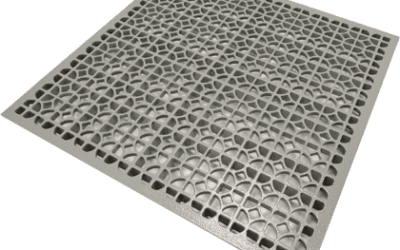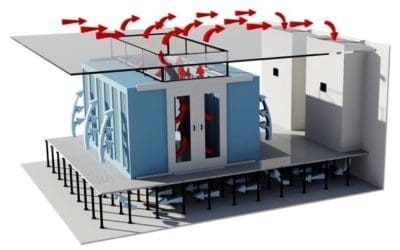As the demand for high-performance computing accelerates across industries, data centres face a mounting thermal challenge. The rise of artificial intelligence workloads, dense server architectures, and edge computing environments has reshaped what efficient cooling must achieve in 2025.
High-density racks now routinely exceed 50kW, with hyperscale leaders already engineering for 600kW per rack. These shifts mark a turning point; airflow management is no longer an auxiliary consideration. It has become foundational to infrastructure resilience.
At EziBlank, our focus remains on elevating cooling efficiency through modular, ergonomic airflow solutions that integrate cleanly within both legacy and next-generation environments.
In this evolving thermal landscape, the question isn’t if data centres must adapt, but how they can do so with intelligence, precision, and sustainability in mind.
AI-Powered Thermal Optimisation: From Monitoring to Decisioning
The first wave of cooling innovation in 2025 centres on artificial intelligence, moving beyond passive monitoring toward real-time, autonomous thermal adjustment. AI platforms like EkkoSense now allow operators to visualise and model live thermal conditions through digital twins, enabling continuous cooling optimisation without the need for guesswork.
These systems not only reduce energy consumption but also actively prevent airflow recirculation zones from forming, which often go undetected in static layouts. When combined with structured containment, adaptive cooling becomes a measurable performance driver, not a theoretical gain.
For operators navigating tighter sustainability mandates and rising rack loads, predictive thermal modelling is quickly becoming a strategic asset.
Liquid Cooling at Scale: Evolution, Not Elimination
Immersion and direct-to-chip cooling are no longer experimental options; they’re strategic tools now being deployed across high-density AI and machine learning environments. Liquid removes heat up to 3,500 times more effectively than air, enabling the kind of rack consolidation that hyperscale facilities demand.
Facilities across Europe and APAC have already committed to multi-megawatt liquid deployments, with major cloud providers building liquid-first architectures to support generative AI expansion.
However, this evolution doesn’t render airflow infrastructure obsolete. Many sites are deploying hybrid systems, where precision airflow tiles and containment panels continue to mitigate leakage and hot aisle contamination.
Raised floor airflow still plays a crucial role in transitional facilities, particularly where modular retrofits must support both air and liquid-cooled racks. In these environments, thermal zones remain a design imperative.
Modular Airflow Systems Enable Scalable Efficiency
Adaptability defines the most successful cooling strategies in 2025. As workloads shift and rack densities fluctuate, infrastructure must evolve in step. Tool-free modular systems, such as blanking panels and directional airflow tiles, offer a practical response.
Snap-on designs allow operators to seal unused RU space without tools, reducing recirculation and optimising cold aisle integrity.
These elements work in concert with floor-level airflow control. Directional tiles, when strategically deployed, distribute conditioned air directly toward high-demand zones. With adjustable dampers and robust aluminium construction, airflow can be tailored in real time to match fluctuating thermal loads.
For facilities designing new builds or upgrading existing aisles, modularity extends to containment as well. The EziBlank Wall system exemplifies this evolution, offering a panelised containment solution that blends architectural cleanliness with airflow precision.
When airflow paths are sealed with intention, cooling systems operate more efficiently and with less overhead.
Containment Evolution: Beyond Basic Cold Aisles
Containment has matured from a tactical airflow solution into a central pillar of data centre design strategy. Once dominated by vinyl curtains and makeshift barriers, modern containment now demands precision, aesthetics, and modular functionality.
The evolution is particularly evident in rack-to-ceiling airflow containment systems. The EziBlank Wall provides a panel-based alternative that aligns with architectural expectations while delivering measurable thermal gains.
Each wall segment is designed for tool-free installation and seamless adaptation to existing IT environments, ensuring airflow is directed with intent and leakage is minimised.
Effective containment enables cold and hot aisle separation to persist regardless of rack layout changes. This stability reduces energy waste and supports greater rack densities without compromising equipment reliability.
In 2025, airflow sealing is less about closing gaps and more about preserving the engineered thermal zone with consistency and control.
Automation and DCIM Integration Shape Cooling Intelligence
Cooling decisions are increasingly informed by infrastructure data, not intuition. Integration between thermal systems, cable management platforms, and IP control software allows data centres to respond dynamically to changing conditions.
With Patch Manager, asset-level modelling supports airflow planning by correlating equipment location, cabling density, and thermal output. This spatial intelligence complements the predictive capabilities of thermal digital twins, offering a holistic view of airflow performance.
Infoblox adds another layer of visibility. By automating IP address management and linking network infrastructure to environmental monitoring, data centre operators can track not only equipment connectivity but also cooling impacts across virtual and physical domains.
The result is infrastructure synergy, where airflow zones are not only sealed but also optimised in real time through cross-platform coordination. Automation strengthens predictability, reduces manual overhead, and makes data centres more resilient to both thermal risk and operational drift.
Regulatory Pressure and Green Mandates Refine the Standards
The regulatory environment in 2025 reflects the sector’s dual responsibility: expand digital infrastructure while advancing environmental accountability. ASHRAE 90.4 and similar standards now influence both equipment choices and airflow system designs.
UL94-V0 flame-retardant materials, such as those used in EziBlank’s blanking panels, are no longer an option; they are expected in professional-grade infrastructure. Beyond compliance, such attributes reduce insurance risk and support long-term sustainability targets.
Operators must also consider Scope 1 and Scope 2 emissions in their cooling strategy. Efficient airflow containment reduces overcooling, lowers fan usage, and contributes to facility-wide carbon reduction.
Facilities participating in the Climate Neutral Data Centre Pact or preparing for stricter EU directives increasingly look to modular airflow solutions as part of their emissions strategy, not merely an operational feature.
Designing for the Edge and the Enterprise
Cooling strategies must now accommodate a broader range of data centre types. Edge deployments require compact, responsive systems with low energy overhead, while enterprise environments demand scalable, integrative designs that align with uptime and compliance frameworks.
Modular airflow systems meet both needs. For edge facilities, snap-on panels and tool-free floor tiles simplify deployment in constrained environments. For enterprise campuses, scalable containment systems allow phased upgrades without disrupting active workloads.
EziBlank solutions are engineered with this duality in mind, providing tool-free, lightweight, and standards-compliant airflow components that enable flexible growth. As edge computing continues to expand and as enterprise data centres pursue higher densities, the ability to adapt quickly will remain a core infrastructure requirement.
The Future Is Contained
Cooling no longer lives at the periphery of data centre strategy. As demands scale in both density and distribution, airflow architecture becomes the backbone of operational efficiency. From immersion systems to AI thermal analytics, every innovation benefits from a physical environment designed to control, direct, and optimise airflow.
EziBlank continues to support this future through modular designs that adapt to evolving rack layouts, uphold global safety standards, and minimise cooling overhead. Whether through snap-on blanking panels, directional airflow tiles, or integrated AI systems via EkkoSense, the outcome is consistent: less recirculation, better thermal performance, and lower energy consumption.
Efficient cooling starts long before airflow reaches the equipment; it begins with how air is managed, sealed, and delivered. The future of data centre cooling is modular, ergonomic, and ready to meet the next generation of infrastructure challenges.
Frequently Asked Questions (2025)
What are the top cooling trends for data centres in 2025?
Key trends include AI-driven thermal optimisation, hybrid liquid-air systems, modular airflow containment, and regulatory alignment with UL94-V0 and ASHRAE 90.4 standards.
Why is airflow containment still important with liquid cooling?
Even with direct-to-chip or immersion systems, airflow containment is critical to prevent hot aisle contamination and to support hybrid deployments where both cooling methods coexist.
How do modular blanking panels improve thermal performance?
Modular panels seal unused RU space, preventing recirculation and reducing cooling loads. Tool-free installation allows quick adaptation during hardware changes without downtime.
Can raised floor airflow systems support edge data centres?
Yes. Directional airflow tiles and brush grommets are ideal for edge sites where compact, energy-efficient cooling is required. These solutions enhance airflow without mechanical complexity.
What role does AI play in cooling efficiency?
AI platforms like EkkoSense model live thermal conditions using digital twins. This enables real-time cooling adjustment and supports predictive maintenance, ensuring optimal airflow with minimal energy waste.




